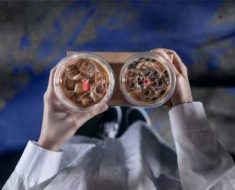Fred Astaire denies feud with Ginger Rogers
We use your sign-up to provide content in ways you’ve consented to and to improve our understanding of you. This may include adverts from us and 3rd parties based on our understanding. You can unsubscribe at any time. More info
With a legacy that lives on through films and going down in history as “humanity’s greatest dancer,” before he died Astaire reportedly crowned Michael Jackson as his “replacement”. He passed away on June 22, surrounded not only by his family but his longtime dance partner Ginger Rogers. Despite suffering from pneumonia, a swelling of the lungs that is caused by bacteria or viral infection, the star remained active well into his old age, even breaking his wrist at 80 after showing off on a skateboard with his grandchildren.
The statement released by his wife Robyn Smith shortly after his death, which captured the love the family had for Astaire read: “I just got in bed with him and put my arms around him and he died in my arms, and that’s the way he wanted it.
“He died holding onto me.″
The 88-year-old was reportedly first taken to hospital a few days before on June 12 with a cold that had worsened to pneumonia, but unbeknown to fans and family at the time, the star was never going to come back out.
Pneumonia is a type of chest infection that affects the tiny air sacs in the lungs, known as alveoli, states leading charity Asthma + Lung UK. For individuals with pneumonia, when these air sacs become inflamed they also fill with fluid, making it much harder to breathe.
DON’T MISS: Hair loss: 5 foods to eat for fuller and stronger locks – dietitian’s recommendations

Symptoms of pneumonia
Symptoms of the condition can either suddenly develop over 24 to 48 hours or come on slowly over a few days, with symptoms typically mirroring those of a common cold or flu.
The main symptom of pneumonia is a cough, which the NHS notes may be dry, or produce thick yellow, green, brown or blood-stained mucus (phlegm).
Other possible symptoms connected with pneumonia include the following:
- Difficulty breathing – your breathing may be rapid and shallow, and you may feel breathless, Even when resting
- Rapid heartbeat
- High temperature
- Feeling generally unwell
- Sweating and shivering
- Loss of appetite
- Chest pain – which gets worse when breathing or coughing.
It is important to note that not everyone who has pneumonia suffers from the above symptoms. On the other hand it is possible to suffer from other, less common symptoms including:
- Coughing up blood (haemoptysis)
- Headaches
- Fatigue
- feeling sick or being sick
- Wheezing
- Joint and muscle pain
- Feeling confused and disorientated, particularly in elderly people.
Asthma + Lung UK adds that some people get a “sharp pain in their chest when they breathe in and out”.
This may be because the thin lining between the lung and rib cage, called the pleura, is infected and inflamed. This inflammation, called pleurisy, stops your lungs moving smoothly as you breathe.
These symptoms are often similar to other chest infections such as bronchitis or COPD flare-ups, so in any case it is important that individuals who have typical symptoms of pneumonia seek medical attention.
Although pneumonia can affect people of any age, it is more common, and can be more serious, in certain groups of people, such as the very young or the elderly. It is these individuals who are more likely to need hospital treatment.

Causes of pneumonia
There are numerous kinds of both bacteria and viruses that can cause pneumonia. The most common is community-acquired pneumonia which is when pneumonia affects somebody who is not already in hospital.
The type of bacteria which causes community-acquired pneumonia is called Streptococcus pneumoniae, but it is possible for individuals to develop this kind of pneumonia through other means.
Asthma + Lung UK explains that community-acquired pneumonia is much less contagious than flu or a cold, because most people’s immune systems can kill the bacteria that causes it before they can cause an infection. Due to this, most people with community-acquired pneumonia are unlikely to give the disease to another person.
In addition to community-acquired pneumonia, other types include:
- Hospital-acquired pneumonia: this is when pneumonia develops while you’re in hospital being treated for another condition or having an operation. People in intensive care on breathing machines are at most risk.
- Viral pneumonia: common causes include the flu in adults and respiratory syncytial virus, particularly in children; this form of pneumonia is often contagious and can spread to affect others
- Aspiration pneumonia: this is when pneumonia is caused by food going down the wrong way, or inhaling vomit, a foreign object or harmful substance. It’s fairly common in the elderly, or people who have conditions that cause swallowing difficulties or reduced level of consciousness
- Fungal pneumonia: this is when pneumonia is caused by fungi. It’s rare in the UK and more likely to affect people with a weakened immune system.

Treating pneumonia
When suspecting pneumonia a GP may be able to diagnose an individual just through asking about symptoms and examining their chest. They may also take your temperature and listen to your chest and back with a stethoscope to check for any crackling or rattling sounds.
For those with mild pneumonia, treatment usually involves getting plenty of rest, taking antibiotics and drinking plenty of fluids. For those who have not had any other health problems, treatment is relatively easy, although a cough may last for some time.
For at-risk groups, pneumonia can be severe and may need to be treated in hospital. This is because it can lead to serious complications, which in some cases can be fatal, depending on a person’s health and age.
Due to the potentially serious nature of the condition, individuals can adopt certain lifestyle habits in order to prevent their risk of developing the condition. These habits include:
- Don’t smoke
- Practise good hygiene
- Avoid alcohol misuse
- Get vaccinated.
Source: Read Full Article





